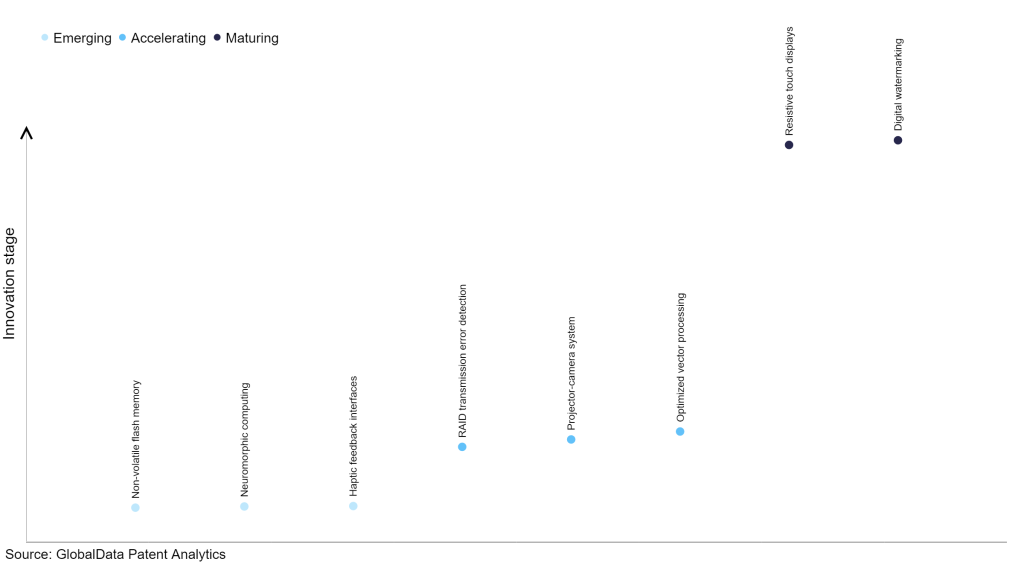The technology industry continues to be a hotbed of patent innovation. Activity is driven by the increasing demand for vibrant and energy-efficient display technologies, as well as the expanding application of OLED screens in various consumer electronics and professional displays, and growing importance of technologies such as algorithms and control circuits to dynamically adjust pixel luminance levels, ensuring consistent and high-quality visual output. In the last three years alone, there have been over 1.5 million patents filed and granted in the technology industry, according to GlobalData’s report on Innovation in technology: OLED pixel compensation circuits. Buy the report here.
However, not all innovations are equal and nor do they follow a constant upward trend. Instead, their evolution takes the form of an S-shaped curve that reflects their typical lifecycle from early emergence to accelerating adoption, before finally stabilizing and reaching maturity.
Identifying where a particular innovation is on this journey, especially those that are in the emerging and accelerating stages, is essential for understanding their current level of adoption and the likely future trajectory and impact they will have.
185+ innovations will shape the technology industry
According to GlobalData’s Technology Foresights, which plots the S-curve for the technology industry using innovation intensity models built on over 1.6 million patents, there are 185+ innovation areas that will shape the future of the industry.
Within the emerging innovation stage, non-volatile flash memory, neuromorphic computing, and haptic feedback interfaces are disruptive technologies that are in the early stages of application and should be tracked closely. RAID transmission error detection, projector-camera system, and optimized vector processing are some of the accelerating innovation areas, where adoption has been steadily increasing. Among maturing innovation areas are resistive touch displays and digital watermarking, which are now well established in the industry.
Innovation S-curve for the technology industry

OLED pixel compensation circuits is a key innovation area in technology
OLED pixel compensation circuits are integral components found in image display devices and pixel circuits. Their purpose is to rectify irregularities in pixel brightness that arise from disparities in OLED materials and production processes. These circuits commonly employ amplifiers, data drivers, and capacitors to regulate the voltage supplied to the pixels, thus mitigating non-uniformity.
GlobalData’s analysis also uncovers the companies at the forefront of each innovation area and assesses the potential reach and impact of their patenting activity across different applications and geographies. According to GlobalData, there are 170+ companies, spanning technology vendors, established technology companies, and up-and-coming start-ups engaged in the development and application of OLED pixel compensation circuits.
Key players in OLED pixel compensation circuits – a disruptive innovation in the technology industry
‘Application diversity’ measures the number of applications identified for each patent. It broadly splits companies into either ‘niche’ or ‘diversified’ innovators.
‘Geographic reach’ refers to the number of countries each patent is registered in. It reflects the breadth of geographic application intended, ranging from ‘global’ to ‘local’.
Patent volumes related to OLED pixel compensation circuits
| Company | Total patents (2010 - 2022) | Premium intelligence on the world's largest companies |
| Casio Computer | 59 | Unlock Company Profile |
| AUO | 458 | Unlock Company Profile |
| Apple | 458 | Unlock Company Profile |
| Novatek Microelectronics | 68 | Unlock Company Profile |
| LG Display | 4287 | Unlock Company Profile |
| Hon Hai Precision Industry | 38 | Unlock Company Profile |
| Panasonic | 179 | Unlock Company Profile |
| Canon | 205 | Unlock Company Profile |
| Sony Group | 1716 | Unlock Company Profile |
| Sharp | 590 | Unlock Company Profile |
| Innolux | 198 | Unlock Company Profile |
| Visionox Technology | 60 | Unlock Company Profile |
| Seiko Epson | 537 | Unlock Company Profile |
| Japan Display | 348 | Unlock Company Profile |
| JOLED | 867 | Unlock Company Profile |
| Semiconductor Energy Laboratory | 2046 | Unlock Company Profile |
| IGNIS Innovation | 469 | Unlock Company Profile |
| Kunshan Govisionox Optoelectronics | 152 | Unlock Company Profile |
| Shenzhen Royole Technologies | 45 | Unlock Company Profile |
| Kunshan New Flat Panel Display Technology Center | 39 | Unlock Company Profile |
| Kabushi Kaisha Limited Energy Kenkyusho | 56 | Unlock Company Profile |
| Janpan Organic Rate Display | 302 | Unlock Company Profile |
| Shenzhen Huaxing Optoelectronics Technology | 78 | Unlock Company Profile |
Source: GlobalData Patent Analytics
Among the companies innovating in OLED pixel compensation circuits, LG Display is one of the leading patents filers. The company’s patent describes the device that includes a display panel with pixels for images. Some of these pixels have a circuit and a light-emitting part. The circuit controls current for the light-emitting part using transistors and capacitors at different nodes. Some of the other prominent patent filers in the space include Samsung Group and Beijing Electronics.
In terms of application diversity, Samsung Group leads the pack, while Beijing Electronics and LG Display stood in second and third positions, respectively. By means of geographic reach, Manpower Group held the top position, followed by Semiconductor Energy Laboratory and Xiaomi.
OLED pixel compensation circuits play a crucial role in ensuring uniform brightness and color accuracy in OLED displays. By mitigating the effects of material and manufacturing variations, these circuits enhance the overall visual quality and lifespan of OLED screens, contributing to a superior viewing experience for users.
To further understand the key themes and technologies disrupting the technology industry, access GlobalData’s latest thematic research report on Technology.
Data Insights
From

The gold standard of business intelligence.
Blending expert knowledge with cutting-edge technology, GlobalData’s unrivalled proprietary data will enable you to decode what’s happening in your market. You can make better informed decisions and gain a future-proof advantage over your competitors.







